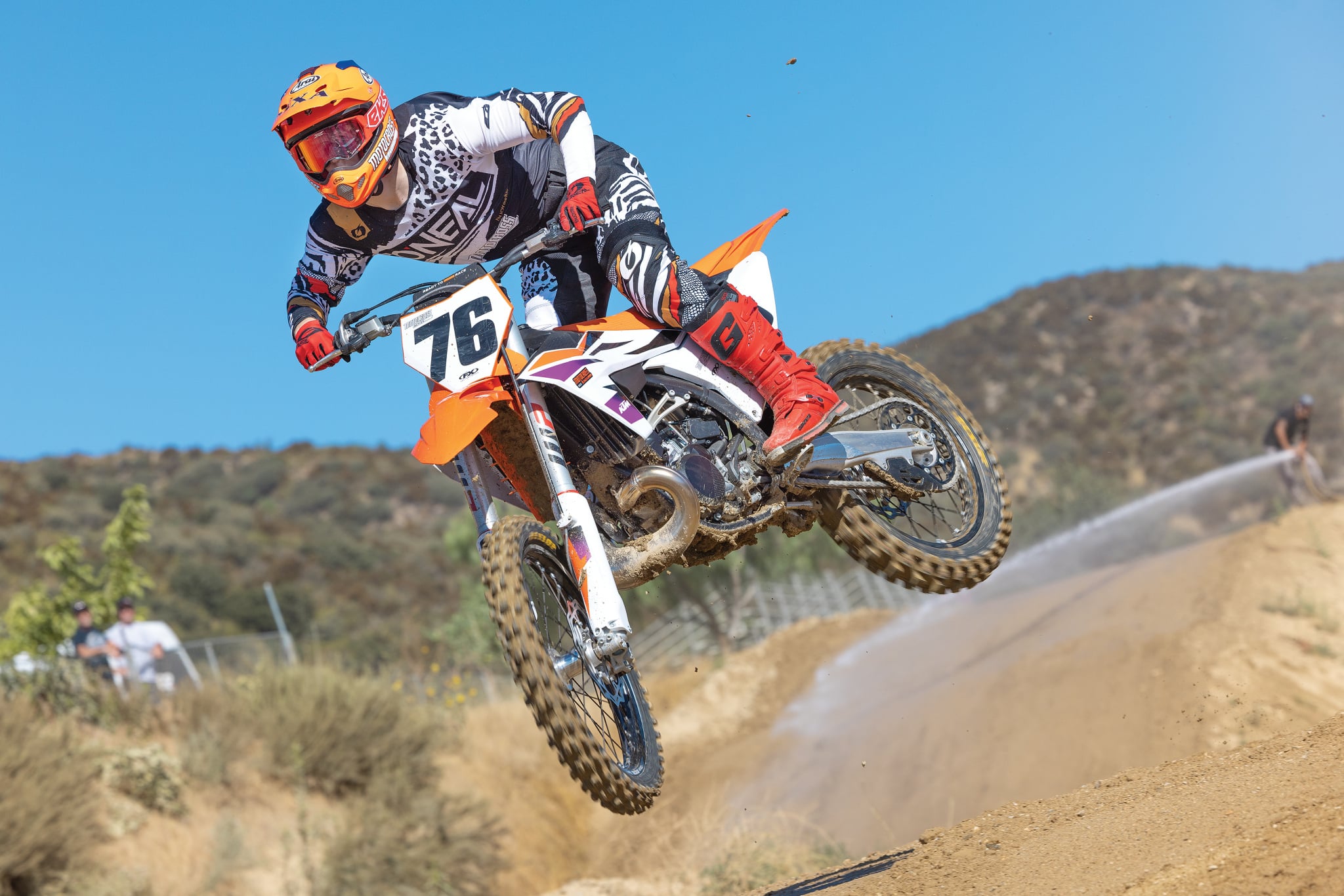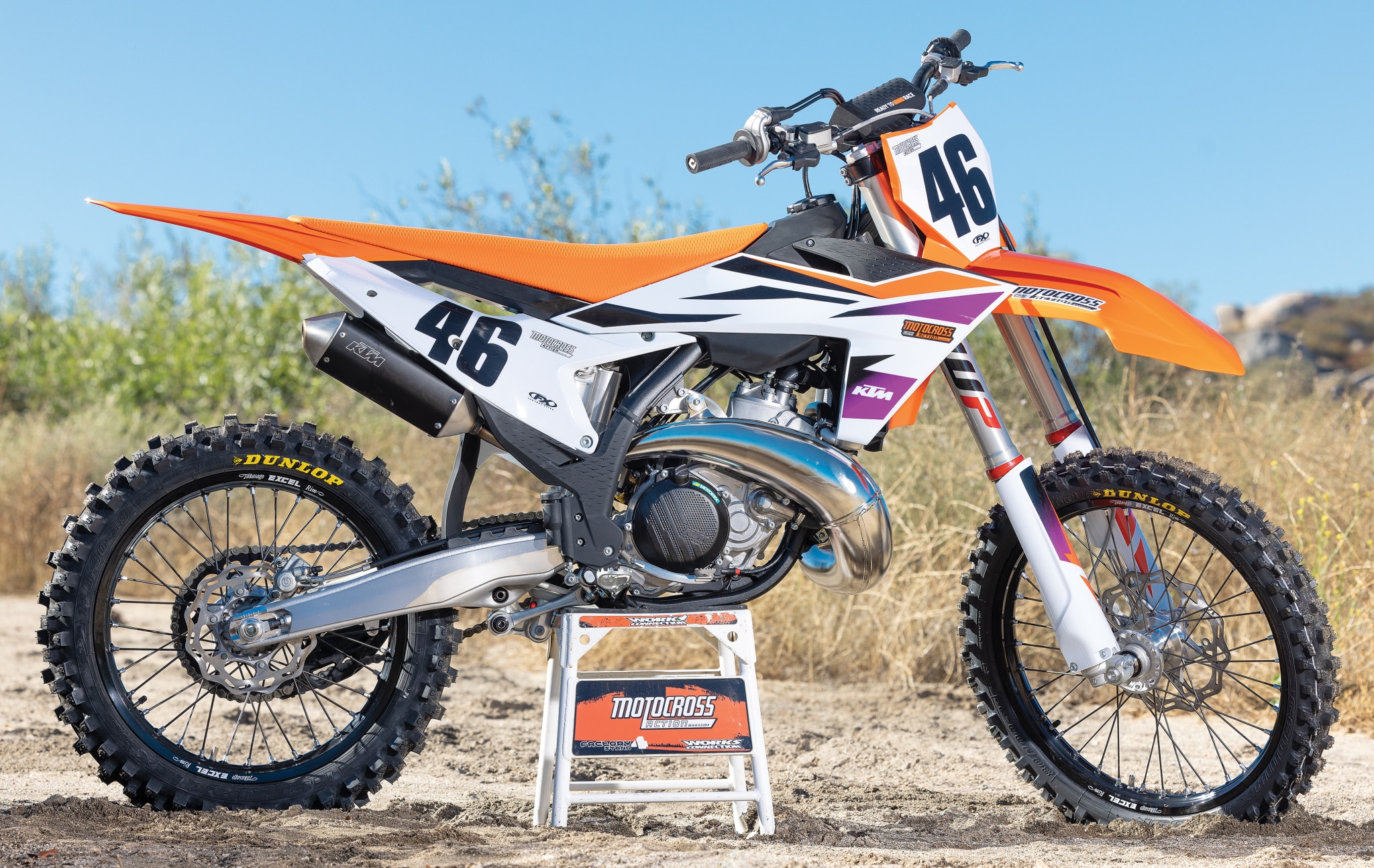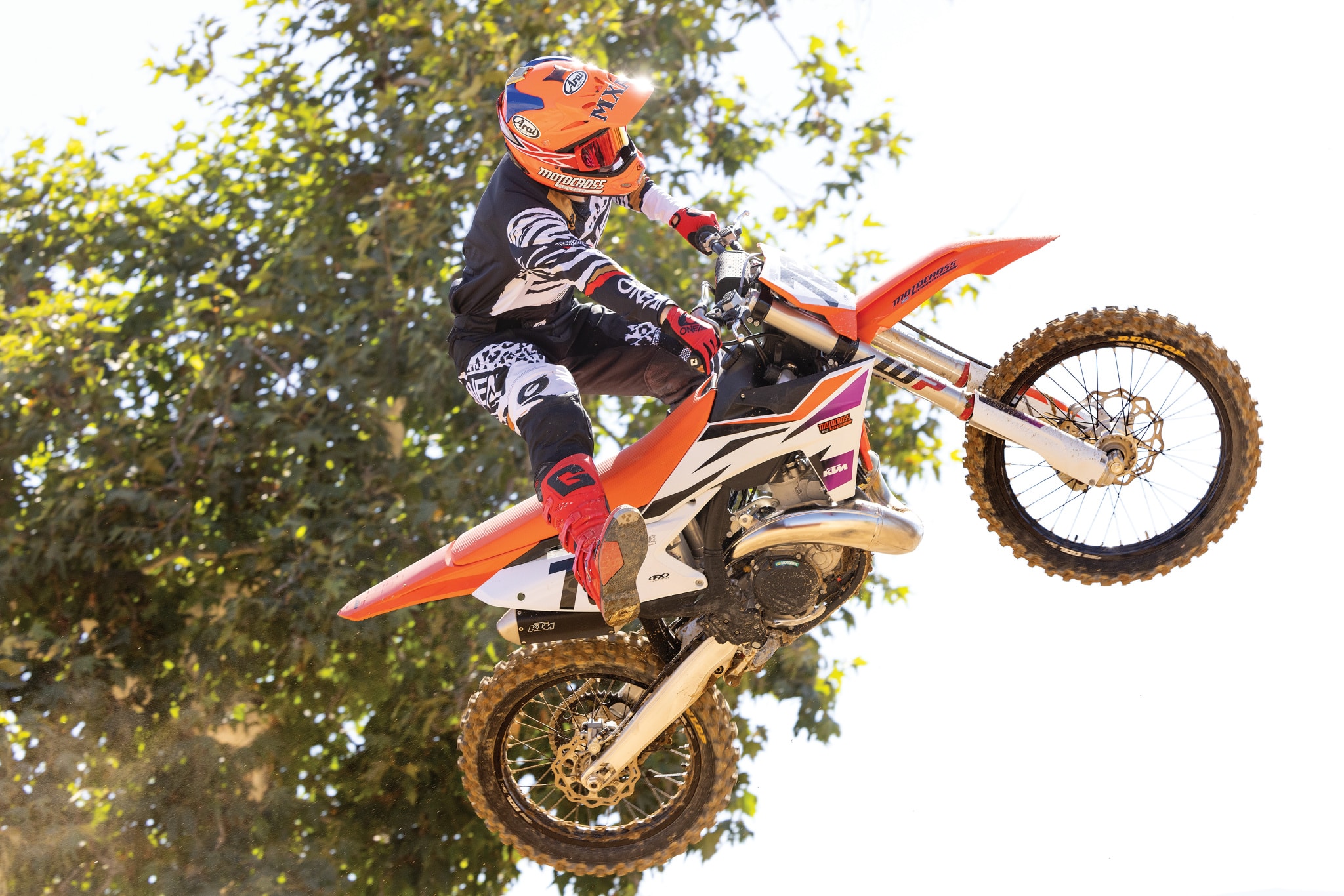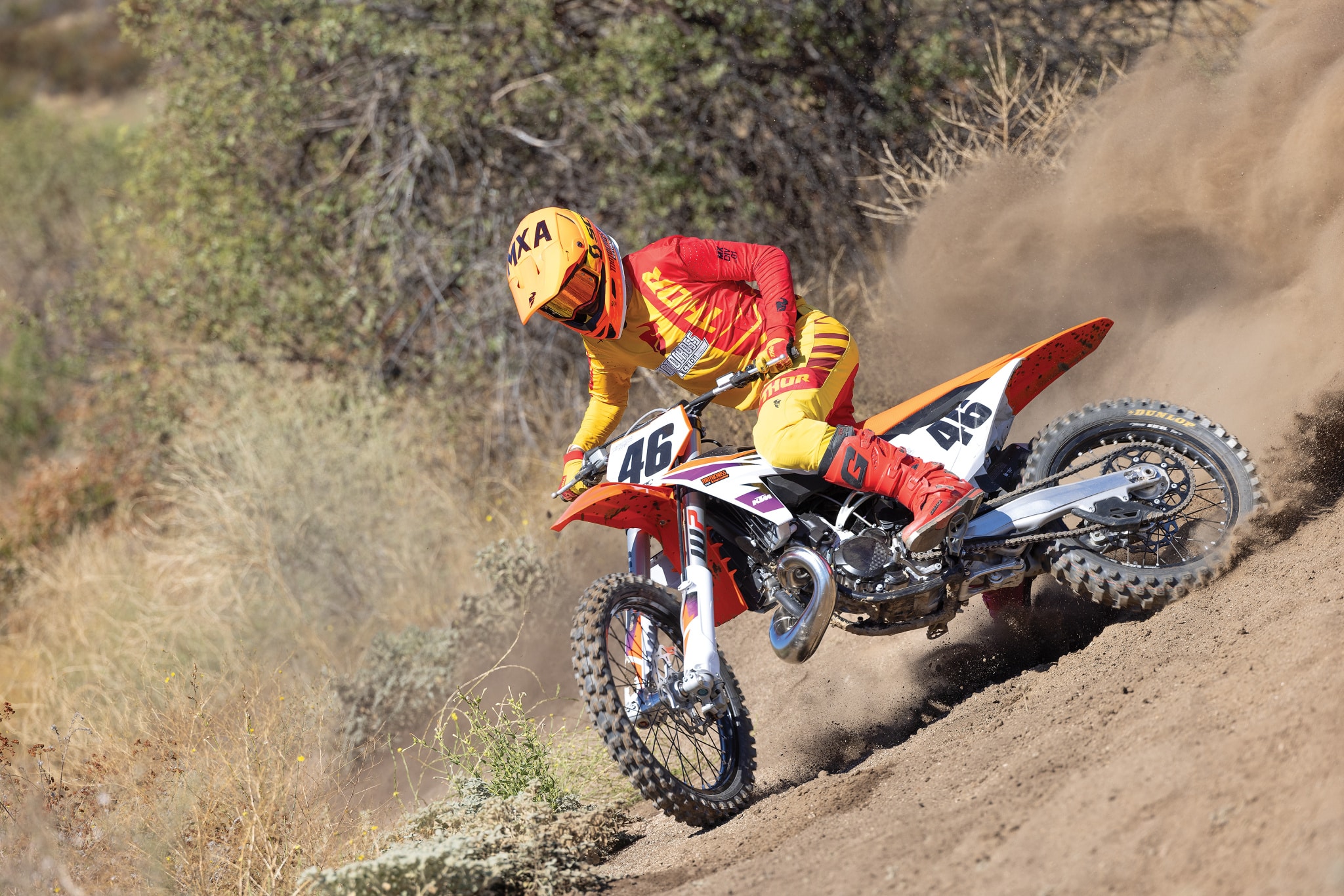MXA RACE TEST: THE REAL TEST OF THE 2024 KTM 250/300SX TWO-STROKES
 The 2024 KTM 250SX two-stroke is ready to race in virtually every class.
The 2024 KTM 250SX two-stroke is ready to race in virtually every class.
Q: FIRST AND FOREMOST, ARE THE 2024 KTM 250/300SX TWO-STROKES BETTER THAN THE 2023 MODELS?
A: The 2024 KTM 250SX and 300SX models are nearly identical to the 2023 models, with minor updates to the suspension settings (aimed at improving chassis balance); however, the 2025 KTM models will have some real changes. Those bikes will have a new frame, new engine mounts, an updated swingarm and linkage to improve flex as well.
The MXA test riders all love the 2025 updates (because we’ve tested them on the 2024-1/2 KTM 250SXF and 450SXF Factory Editions), but we believe the chassis updates will benefit the 450SXF more than the two-stroke models. The 2023–2024 450SXF was too rigid, while the two-strokes naturally come with softer suspension and have less engine braking, which improves overall handling. The two-stroke engine character gelled better with this 2023-generation chassis than the 450SXF.
Q: WHAT’S THE DIFFERENCE BETWEEN THE 250SX AND THE 300SX?
A: The differences are probably fewer than you would guess. Of course, the 300SX is an Open-class bike. Although it’s not allowed to be raced in the 450 class at AMA-sanctioned events like Supercross or in the AMA National motocross series, it is allowed in all Vet classes.
Structurally, the KTM 250SX and 300SX are nearly identical. The 300SX is built off of the 250SX model, only with a bigger bore. The 250SX has a 66.4mm bore with a 72mm stroke. The 300SX shares the same bottom end as the 250SX, but its bore and stroke measures at 72mm x 72mm. That extra bore in the cylinder adds up to an extra 43cc of displacement, bumping the 300SX to 293cc.
 The 2024 KTM 300SX two-stroke is an “Open class” bike. Built for Vet classes, two-stroke classes and professional practice riders.
The 2024 KTM 300SX two-stroke is an “Open class” bike. Built for Vet classes, two-stroke classes and professional practice riders.
Q: WHAT IS THE FUSS ABOUT TWO-STROKE FUEL INJECTION?
A: Fuel injection on two-strokes is something the two-stroke community isn’t quite accustomed to. Without carburetors, these two-strokes no longer rely on fixed orifices (main jets and pilot jets) to regulate how much fuel gets to the combustion chamber. These new-generation, fuel-injected two-strokes rely on the ECU to tell the throttle body how much fuel and air to send into the combustion chamber. They also have dual injection, with one injector in front of the butterfly valve and one behind it for optimal fuel atomization.
Another new feature for “smart two-strokes” is an electronic power valve. It’s not the first time a two-stroke has had an electronic power valve. Honda had them back in the day on their two-strokes, but they were controlled by engine rpm and activated by cables. The new KTM power valves are controlled by the bike’s brain (ECU). This way, KTM can manipulate how slowly or quickly the power valve opens to customize the hit of the power. In map one (white), the power valve only opens 80 percent, significantly muting the power. In the green map, the power valve opens all the way, letting the engine breathe without restriction.
Q: HOW DO THE 250SX AND 300SX FUEL-INJECTED TWO-STROKE ENGINES RUN?
A: Compared to the carbureted two-strokes that we all know and love, the new-generation, fuel-injected smokers are weird. Because of the fuel-injection system, they don’t have the same two-stroke hit. The new powerband is nice in that it has a very connected throttle-to-rear-wheel feel. As soon as you roll into the power, the 250SX and 300SX get going without any bog, hit or surge. They truly feel like a fuel-injected four-stroke in the corners, or like a carbureted two-stroke with the jetting dialed in perfectly. The second weird part about them is how quickly the EFI two-strokes rev out.
In stock form, the 300SX hits a peak of 55 horsepower at 8500 rpm, while the 250SX hits 52.1 horsepower at 8600 rpm. The rev limiter kicks in soon after that, but it feels like it comes on prematurely. It doesn’t give off the same feeling that a standard two-stroke gives when it starts to run out of fuel. When a pre-2023 KTM 250SX begins to run out of fuel on top, it reminds you to shift, while the 2023-and-newer two-strokes don’t give any warning. They go from full power to rev limiter quickly.
One more note about the rev limiter: our test riders realized quickly that it typically kicks in when you pull the clutch in and rev the bike or when you rev the bike mid-air. When you’re on the ground and the engine is under a load, the rev limiter is less intrusive.
 KTM locked the ECU on their new two-strokes, but WMR and Twisted Development have cracked the code, unlocking power that really helps these bikes.
KTM locked the ECU on their new two-strokes, but WMR and Twisted Development have cracked the code, unlocking power that really helps these bikes.
Q: HOW DO THE 250SX AND 300SX ENGINES COMPARE?
A: Off the crack of the throttle, both bikes feel connected and smooth. In the midrange, the 300SX shows its strength, and the extra 43cc are noticeable in that you don’t have to shift as much as you do on the 250SX. The 300SX enjoys being lugged in second and third gear around the turns. Once it’s time to open up the throttle, the 250SX revs through the gears quicker, while the 300SX allows you to be more relaxed with your shifting.
Q: HOW IS THE MAPPING?
A: We think the stock mapping is off to a good start, but both engines do run flat when they are high in the rpm range. For a while, engine builders wouldn’t touch the new generation two-strokes. Many tuners were scared and unsure of what to do with the new technology. KTM had locked its ECUs starting on the 2021-1/2 models and added a whole new set of firewalls that wouldn’t allow engine tuners to break into the ECUs to customize the mapping like before. Vortex was still making ECUs for tuners like Jamie Ellis to work with on the 2022 bikes; however, on the new 2023–’24 two-strokes, KTM switched from Keihin to Continental ECUs, which meant that Vortex ECUs were no longer compatible. It took time, but eventually tuners like Jamie Ellis and the guys from WMR in Florida finally cracked the ECU code, which allowed them to remap the new black boxes.
With Twisted Development’s remapped ECU, you still get the luggable and easy-to-ride bottom end, but you gain a bit more throttle response along with a gracious amount of mid-to-top pulling power. After the remapping, you won’t constantly be hitting the rev limiter; the bike will keep pulling. Twisted Development mapped our 300SX to run with a Pro Circuit pipe and stock silencer. This remap gave us the ability to use third gear in even the tightest corners, and it let the bike rev further. The combination of Pro Circuit and the re-mapped ECU brought our 2024 KTM 300SX to life.
 The KTM 300SX is the big brother of the KTM 250SX. Everything is the same except the cylinder and piston.
The KTM 300SX is the big brother of the KTM 250SX. Everything is the same except the cylinder and piston.
Q: HOW IS THE SUSPENSION?
A: Both the 2024 KTM 250SX and 300SX two-strokes come with the standard WP XACT air forks and WP shock. We appreciate how easy it is to adjust the compression and rebound clickers by hand on the forks and the high- and low-speed compression clickers by hand on the shock; however, the rebound clicker on the shock still requires a flathead screwdriver.
Once you set the sag at 105mm and dial in the fork’s air pressure for your weight, both bikes are very balanced. The suspension might be on the soft side for heavier or faster riders or for those who ride in deep loam or sand. The stock settings are great for West Coast conditions where the dirt usually has a harder base.
Q: WHAT’S UP WITH THE KYMCO CYLINDER?
A: Kymco is a Taiwanese motorcycle manufacturer best known for making mopeds. Naturally, the internet went crazy when photos of the new KTM two-stroke engines were released with Kymco logos embossed on them.
The Kymco/KTM collaboration started with their TPI (transfer port injection) two-stroke engines. KTM’s original cylinder supplier couldn’t make enough parts at the time, and KTM needed a backup plan. Now, KTM has two suppliers for one part. KTM assured us that the Kymco cylinders aren’t better or worse in any way. KTM developed the part, and their quality control manager ensured that it meets all the same requirements as every other KTM cylinder. Of course, KTM did due diligence on durability and peak power, and the performance is the same.
 We love how easy these bikes roll into the power and hate how easy they hit the rev limiter.
We love how easy these bikes roll into the power and hate how easy they hit the rev limiter.
Q: WHAT’S UP WITH THE TORQUE CHAMBER?
A: Another cool addition to the new Austrian 250/300 two-strokes is the “torque chamber,” which is positioned at the exhaust port in the cylinder head. It is much like the old Honda HPP chamber. At the moment of combustion inside of the cylinder, a wave is triggered. This wave is made up of exhaust fumes and some unburned fuel. It goes into the exhaust pipe and rebounds back. On its way back, the unburned fuel acts as a charger to add more fuel mixture and create more power.
At low rpm, the torque chamber works like a bypass in conjunction with the power valve. The chamber is open at low rpm so the exhaust pressure can hide during the low-rpm moments. This way it doesn’t hinder the piston’s rotation. When the excess fuel escapes into the chamber, the piston can work normally without issues.
At high rpm, the chamber closes. This allows the unburned fuel to come back into the combustion chamber quickly. You get the peak horsepower, like a turbocharger, when the exhaust pressure and unburned fuel rebound back into the combustion chamber.
 Fuel-injected engines require lots of electronics that aren’t normally found on two-strokes.
Fuel-injected engines require lots of electronics that aren’t normally found on two-strokes.
Q: WHAT DID WE HATE?
A: The hate list.
(1) Bodywork. Removing plastics on the 2023+ KTMs is a tricky process. To remove the side number plates, you have to take off the seat and the rear fender. You should know the rear fender has six different bolts holding it on.
(2) Spokes. The spokes still come loose, especially by the rim lock. The sprocket bolts need to be watched closely as well, especially breaking in the wheels in the wheels.
(3) Radiator cap. The plastic radiator cap was implemented because Marvin Musquin somehow kicked the old radiator cap off with his leg. We wish KTM could go back to a traditional radiator cap.
(4) Subframe. The bottom subframe bolts aren’t easy to line up with the frame and thus are easy to strip. You have to wiggle the rear end around to get the bolt to line up correctly.
(5) Rev limiter. We still aren’t used to the rev limiter. Thankfully, Twisted Development has learned how to break into and customize the ECUs now.
 The KTM 250SX suspension is decent once you understand its intricies. It’s very balanced and easy to tune.
The KTM 250SX suspension is decent once you understand its intricies. It’s very balanced and easy to tune.
Q: WHAT DID WE LIKE?
A: The like list:
(1) Fuel injection. The new EFI system makes for smooth and easy-to-ride low-to-mid power.
(2) Suspension. Once you learn the ideal air pressure for your weight and speed, the WP XACT forks work very well. The shock is super easy to dial in.
(3) Brakes. Brembo’s brakes are still the best around.
(4) Power valve. The new electric power valve contributes to the smooth power and allows for dual map options.
(5) Shock collar. The 2023 and up shock collars are more durable and work much better. You don’t feel like you’re destroying your shock when setting the sag.
(6) Electric starting. It doesn’t feel necessary on a two-stroke, but once you get used to it, it’s a nice addition.
 Pro Circuit’s pipe and silencer make a big difference on the 300SX.
Pro Circuit’s pipe and silencer make a big difference on the 300SX.
Q: WHAT DO WE REALLY THINK?
A: For longtime two-stroke lovers, like the MXA test riders, it will take some time to get used to the fuel-injected smokers. The added electronics complicate things when it comes to modifications and maintenance; however, they do eliminate the need for jetting your bike to suit different environments. The 2024 KTM 250SX and 300SX are great for riders who want a two-stroke but don’t fully understand the intricacies of jetting.







Comments are closed.